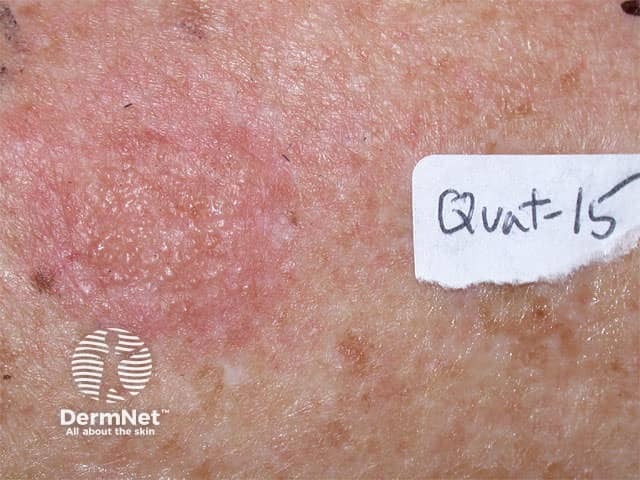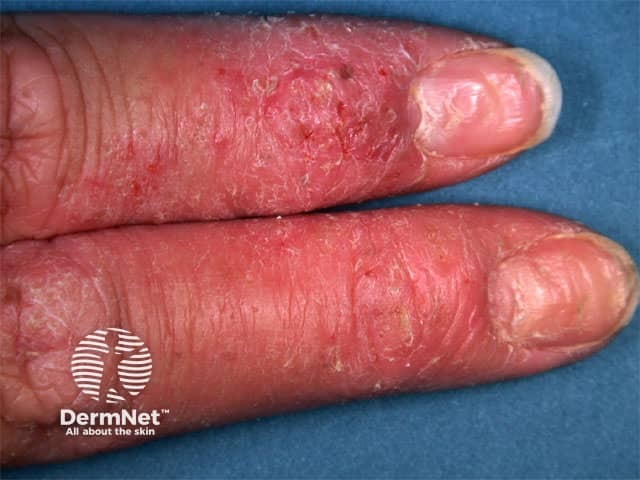Main menu
Common skin conditions

NEWS
Join DermNet PRO
Read more
Quick links
Last Reviewed: July, 2024
Author: Vanessa Ngan, Staff Writer (2002); updated by Dr Ian Coulson, Dermatologist, United Kingdom (2024).
Edited by the DermNet content department.
Introduction
Clinical features
Diagnosis
Treatment
Prevention
Alternative names
Further information
Reference
Quaternium-15 is a formaldehyde-releasing preservative. It is used in many cosmetics and pharmaceutical preparations. It is also used as a preservative in many commercial and industrial products. The table below shows some of the products that may contain quaternium-15.
Cosmetics |
Self-hygiene/pharmaceutical products |
Commercial/industrial products |
|---|---|---|
|
|
|
Individuals reacting to quaternium-15 may be either sensitive to formaldehyde or have a specific sensitivity. Typical allergic contact dermatitis reactions may occur from either of these sensitivity types.

Positive patch tests

Hand dermatitis

Facial dermatitis
Quaternium-15 allergy is diagnosed from the clinical history and by performing special allergy tests, i.e. patch tests. Patch testing with 1% quaternium-15 in petrolatum is used. Many individuals allergic to quaternium-15 react to formaldehyde also.
Self-testing a product for quaternium-15 is possible but should be done only after first talking with your doctor. This should be done only with products that are designed to stay on on the skin such as cosmetics (not including eyeliners or mascaras) and lotions. Apply a small amount of the product to a small tender area of skin such as the bend of your arm twice a day for 1 week. Examine the area each day and if no reaction occurs, repeat the test on a small area in front of your ear. If no reaction occurs, you are unlikely to be allergic to it. Even so, you should still be cautious if you are intending to use it over large areas, as it may still be an irritant.
Products such as shampoos, soaps and cleansers should not be tested in this way as they may cause an irritant dermatitis, if they are covered or overused on tender areas.
If you are diagnosed with quaternium-15 allergy then avoid exposure to quaternium-15-containing products.
Once the dermatitis appears on the skin, treatment is as for any acute dermatitis/eczema, i.e. topical corticosteroids, emollients, treatment of any secondary bacterial infection (Staphylococcus aureus), etc.
Read product labels and avoid products that contain quaternium-15 or any of its alternative names.
Avoid related substances that you may also be allergic to. This includes formaldehyde and other formaldehyde-releasing preservatives found in cosmetics, topical agents, as well as industrial and metalworking fluids.
If you react to formaldehyde then all formaldehyde releasing agents below should be avoided with the exception of bronopol should the specific reaction to this be negative. If the reaction is only to one of the formaldehyde releasing agent(s) but not formaldehyde, then only the specific formaldehyde releasing agent need be avoided.
Formaldehyde-releasing preservatives to avoid |
|---|
|
Alert your doctor to the fact that you have an allergy to quaternium-15. Your dermatologist may have further specific advice, particularly if you are highly sensitive.
Preparations that contain other types of preservatives, as long as you do not have an allergy to these too, should be safe to use. Ask your pharmacist for advice.
Possible suitable alternative preservatives |
|---|
|
These preservatives can also cause contact allergy.
Quaternium-15 is also known by several other names. These include:
Avoid all of these.
At work, request a material safety data sheet to help identify potential sources of exposure.
Formula: C9H16Cl2N4
CAS number: 51229-78-8
Cross reactions: formaldehyde, formaldehyde-releasing preservatives
Sensitiser: formaldehyde
Patch Test: 1-2% quaternium-15 in petrolatum
Sources of exposure to quaternium-15:
|
|
Book: Fisher's Contact Dermatitis. Ed Rietschel RL, Fowler JF. Lippincott Williams & Wilkins 2001